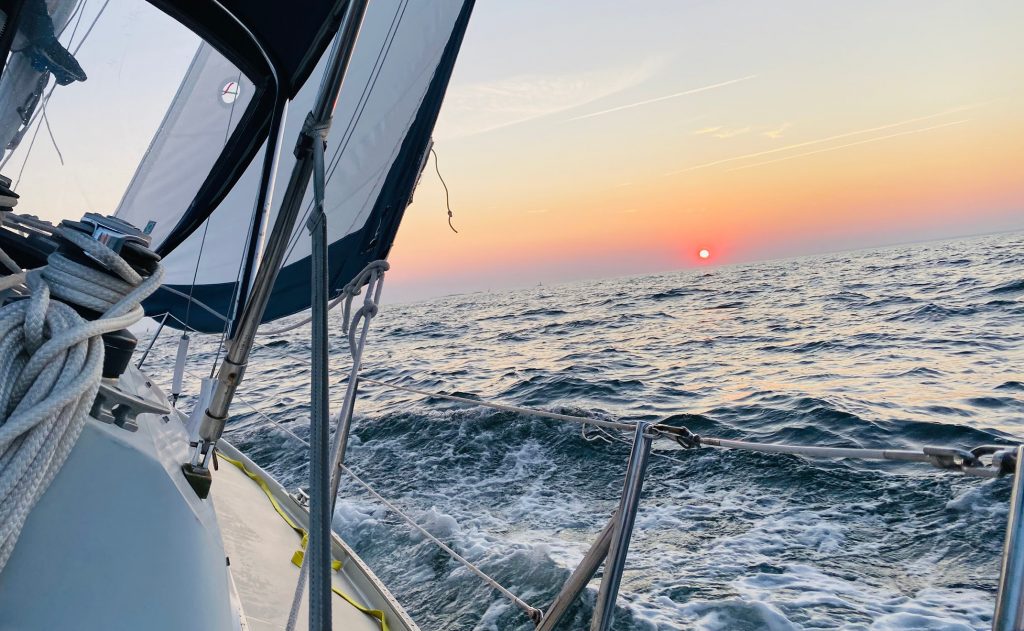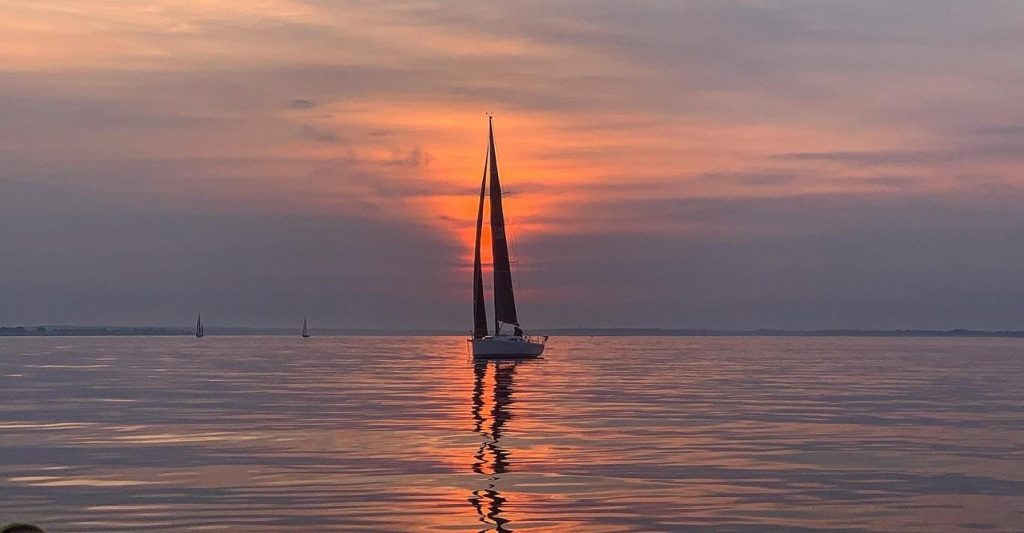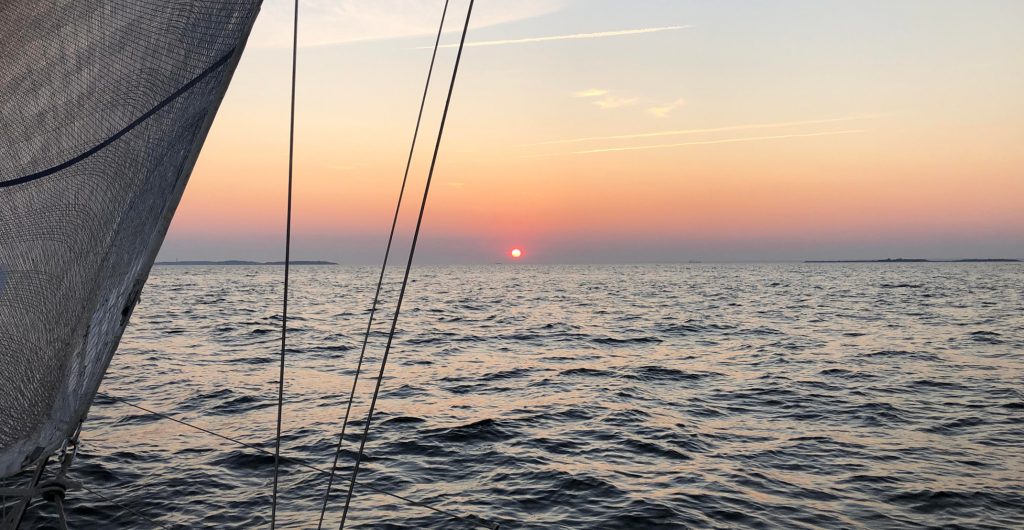By Christopher Cole, S/V Ticker
Editor’s note: A popular part of Mudnite Madness is the Mudnite Photo Contest, and we’ve selected a few entries taken during Mudnite Madness 2021 to illustrate this report.
The Mystic River Mudhead Sailing Association Race Committee always enjoins its competitors, “Go fast, pass boats, tell stories!” Having done the first two during this epic overnight race, I began a brief account of it – which grew ever less brief as I wrote it – as an email message for the amusement of any Tickers not aboard for this event. We made one particular decision during the race that led to a magical moment that I wanted to crystalize and preserve. I learn best while thinking and think best by writing.
We started Mudnite Madness 2021 at 6 p.m. near Horseshoe Reef with perhaps 8 to 10 knots of breeze out of the southwest and nearly slack tide, flood having begun just over half an hour earlier. We got the side of the line we wanted, near the committee boat, but I was a few seconds late, only feet from the stern of a boat ahead and gassing us, so we tacked immediately to port and west to clear our air.
The current was weak and young and so the Sound was still relatively smooth. We made good time. Though some boats that had continued straight across to Fishers were ahead at Race Point Ledge, we were still in the mix, especially after picking our moment to tack onto starboard there better than some boats – or so we thought at the time. Having misread the course description, I began steering for Montauk, staying high to lock in some insurance against a possible backing wind, while we wondered why so many boats had tacked to the west again — and why race instructions bothered mentioning we should leave Valiant to starboard.
The winds south of Fishers were into the mid-teens and the water was rough, with a large underlying swell beneath a confused sea. With the tide coming in and the seas slowing our progress, we considered bearing off a bit but decided to stay high for the time being, cracking the sheets just a bit to foot better, and thus we soldiered on for a while. Then, seeing that most boats were keeping well west and even tacking out that way, we decided to read the course description again.
We discovered that I had missed a mark (the absence of parallel syntax in the instructions and of reading glasses on my nose both contributing to the elision). Before going to Montauk, we were first required to go to a mark north of Gardeners, Gong “1GI”, close to the Ruins. We were not the only boat to make this error. Several boats behind us continued on toward Montauk even after we tacked to port toward the Ruins, and one boat, the scratch boat in our class, had earlier borne off to foot toward Montauk and had continued on that course until he was nearly out of sight. He must have eventually realized his error because he did finish the race, though well behind us.
Fortunately, we had stayed close-hauled and had not quite sailed past the port tack layline to the Ruins. Meanwhile, boats that had read the instructions better than I and had tacked west early seemed to have fared less well than us. They seemed to have less wind, and the incoming current near The Sluiceway and Plum Gut was pulling them somewhat northward while it was sending us directly toward the mark.

Sunset aboard Chris & Kelley Griffin’s Ericson 38-200 Shearwater
As the sun set and sky and sea grew dark, we could see that we would be the third boat to round the mark near the Ruins, with the leaders not out of reach. Again, we picked our moment to tack perfectly, tacking before the mark was abeam and expecting the current to get us around, which it did just as dusk became night, the stern lights of the two boats ahead much closer than the bow lights of the boats behind.
The course to Montauk was a close reach. Ticker does not yet have an asymmetrical spinnaker or Code sail and does not carry the symmetricals effectively when the wind is forward of abeam. Though we could not tell in the dark, we guessed that most of the boats in our class would likely be flying asymmetricals or Code Zeros on this leg. But we also knew that the wind was far enough forward that asymms might be difficult to fly, especially in the dark, and that with this much breeze, Ticker would not necessarily yield many yards under the genoa. While the stern lights ahead did seem to get a bit more distant, the bow lights behind did not appear to close.
With just five of us aboard we got the spinnaker up and drawing nicely in the midnight run from Montauk to Watch Hill. The boats ahead did not pull away, and those behind got no closer. As we got closer to Fishers, the winds became lighter and shiftier. We stayed on port tack all the way, though the pole went up and down, forward and back, with Matt on the sheet assisted by Jay and Marc on the other controls. Especially considering that they were working in the dark, they did a masterful job of keeping the chute aloft and drawing and Ticker burbling along though the pitching seas.
The tide was ebbing now. The lightening wind finally decided to go well aft as we got close to the island, and some of the boats behind went far upwind, apparently intending to tack downwind with two or more gybes in the dark. We resisted the temptation, dreading the prospect of a shift forward again, a bungled gybe, or of sailing too far south and east on the return tack, and then into the strong ebb at Watch Hill.
We were the third boat to round the Watch Hill Reef Gong “G1”. The closest boats behind were perhaps anywhere from a quarter to a half mile back — difficult to judge in the dark, but they had not gained on us. The two boats that had rounded ahead of us just a few minutes earlier had seemed to have a decent breeze going up the passage and into the Sound and had vanished among the lights on shore. But as soon as we rounded, the wind died and we drifted backwards in 2 knots of current while the rest of the fleet caught up. By the time a meager wind filled in again, trailing boats from our class and the other spinnaker class that started after us were all drifting in a clump – our own little galaxy of red, white and green bow, stern, and masthead lights bouncing about in the narrow channel.
The smaller boats did better in the slight breezes that came and went. It took us hours to crawl back to the Watch Hill gong we had rounded, never having gotten all that far from it. By then, most boats had gone to the north shore and out of the worst current and had done better than we had. We were determined to stay upwind, however, close to Fishers and positioned for the flood and hopefully convergent morning breezes.
Here I should perhaps describe our thought process. It seemed a decent gamble to stay near Fishers for four reasons: the current-blocking reefs during the ebb, the quick access to the strong current flow during flood, the upwind position, and the likelihood of better wind later in the morning.

Calm conditions prevailed for much of this year’s Mudnite Madness. © Liz Sistare
In the northern hemisphere, surface level wind backs from the gradient wind over land, so wind blowing from the west quadrant to the east will tend to diverge along a northern shoreline – Connecticut and Rhode Island – and converge along a southern shore – Fishers. Divergent regions are dead zones while convergent winds add their vectors, creating more wind.
Also, we knew that ebb would last until about dawn, and the temperature of the land-heated water of the ebb would not be significantly cooler than either shore in the early morning and might even be warmer. So any convection movement there would probably be from land to sea, and on the north shore that would be blocked by the gradient wind piling up against the shore. So there would be little mixing of layers that could bring down higher altitude winds. Meanwhile, any convection movement off of Fishers to the warmer Sound would be in line with the backed gradient wind, adding more potential energy to the breeze and possibly drawing down higher altitude gradient wind.
We made slow, slow progress past “G1”, but then started going backwards again at Sugar Reef, where we anchored in about 30 feet of water and waited for the tide to turn. We had rounded hours ago but still not passed the east end of Fishers. When the current slowed to perhaps a knot or less, we raised the anchor, tried sailing, drifted back for an anxious minute, and dropped the anchor again. The current continued to slow, however, and partly due to that, enough relative wind eventually came up for us to make a little progress forward, the anchor line straining out to port at a right angle. We raised the anchor and sailed, trying to stay as much behind the reefs north of Fishers as we safely could and so negate some effects of the waning ebb tide. By this time, we appeared to be in last place – but to windward and away from the north shore where, again, the westerly gradient wind and the differences in land and sea temperatures meant that little to no wind would be likely at sunrise.
So, we were where we wanted to be, but for the longest time we seemed to fall only further and further behind. Eventually, however, the ebb slowed and gave way to a slowly building flood that pushed us faster and faster west and into the slight breath of wind, adding just enough to our apparent wind speed that the sails more or less filled out and we began to pick up boat speed and so generate still more apparent wind speed. Soon were gaining on the boats to leeward.

The sun sets Little Gull, as seen from Steven Marenakos’ J/105 Reckless
Then something magical happened. Somewhere in the vicinity of Middle or West Clump, fairly close hauled in what my instruments said was 2.9 knots of true wind, Ticker began making an impossible 2.9 knots through the water. It was like being on one of those people-movers at an airport: we had our own private breeze and current. We began passing boats like cars in a parking lot, not daring to touch a line or deviate from our track. Some boats to the north began to tack out toward Fishers to try to get into our lane, but it was much too late, and we left them far, far behind.
The finish line extended 250 degrees from the center of the Seaflower daymark: that is, we were to note the time when Seaflower bore 110 magnetic. We saw glassy water north of Seaflower as we approached and tacked to avoid it, passing Seaflower to the south, and finishing by falling off to shoot the line west of Seaflower, which we did at 6:32:44 a.m.
Our reward: line honors, first in class, and a bonus for me: my first beer ever before 7 a.m. The odd thing was, I felt great and ready for another race that day – until 9:30 or so, when I was in my car and about halfway back to Middlebury.
Prodding myself to stay awake, I got safely home and was soon reclined comfortably on our awning-covered deck, which rocked me to sleep in the odd cadences of our majestic New England waters. ■
Christopher Cole is a teacher in the Connecticut Technical High School System, the guitarist and vocalist for The Lone Wolf Trio, and the U.S. rep For Loong Sails. He sails his Tripp 37 Ticker – for which he has used a cordless Milwaukee wet vac as a bilge pump for years – out of New London, CT and is a member of the Mudheads and Thames Yacht Club.




